The Dictionary of Moose Cree is a living document that resides in a specialized database that serves as the source for both the online and print editions. It is the only dictionary of the Moose Cree dialect that is officially endorsed by the local cultural committee and that is owned collectively by the community of Moose Factory.
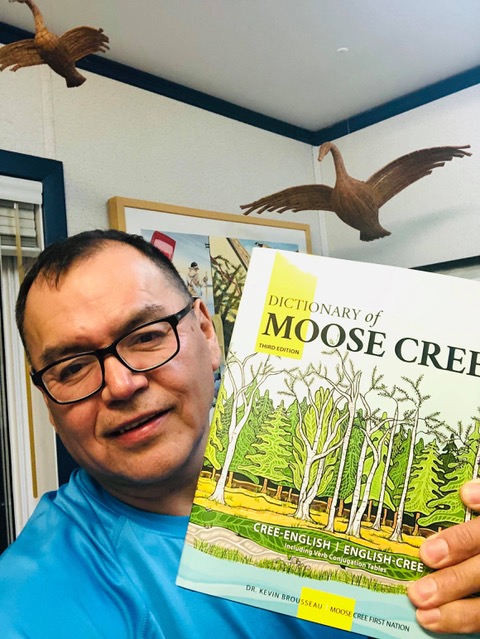
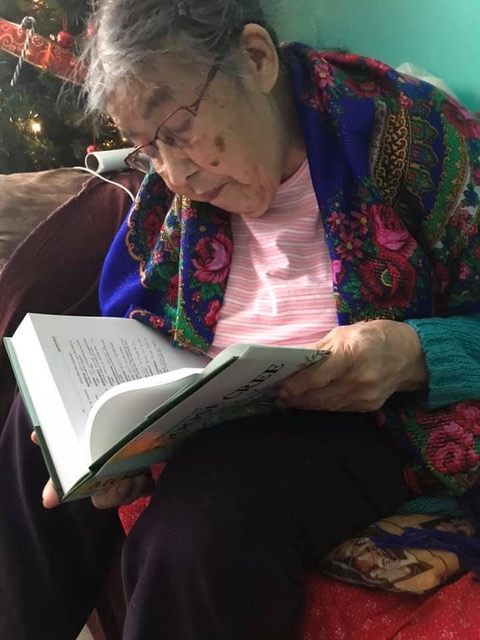
As a bidirectional bilingual dictionary, the Dictionary of Moose Cree presently contains just over 34,340 Cree to English entries and over 12,300 English to Cree translations grouped under 5,500 carefully crafted entries. Given the precarious state of the Moose Cree dialect, the purpose of this dictionary is to safeguard and present all words for which there is evidence of use in this dialect, whether historical or present. This is a tremendous task given the dialect’s literary history. It requires that all written materials in the dialect be meticulously examined and that copious examples of modern speech be recorded and analyzed. In other words, the dictionary is largely supported by a text corpus.
In addition to the creation and examination of this corpus, the process of building this dictionary relies heavily on consultations with expert speakers. This process is ongoing and helps corroborate words and identify vocabulary specific to certain semantic fields.
Cree words in this dictionary are presented in alphabetic and syllabic orthographies, both standardized along phonological and morphological bases.
Four print editions have been published to date, each briefly presented below. A list of fluent Cree-speakers who have contributed their precious time and knowledge to this ongoing project can be found at the right hand of this page. Sadly, some members have since passed on.
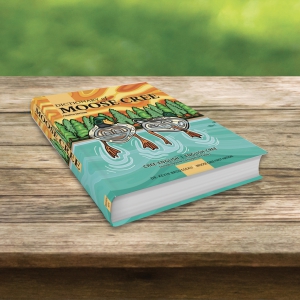
Fourth Edition
Published in 2025, this edition is the most comprehensive dictionary of the Cree language ever published. It is a bidirectional, bilingual dictionary of 1,367 pages containing 34,340 Cree to English entries with over 3,500 example sentences. Entries in this dictionary include sense numbering, cross-references such as synonyms and variants, and etymologies for loanwords.
The English to Cree section contains just over 5,500 carefully selected and meticulously developed entries. These have been designed to help inform readers as to the manner in which words are formed in Cree. The English to Cree section also contains a number of useful tables of related vocabulary such as days of the week, months of the year, and numbers.
This edition also contains nearly two hundred pages of verb conjugation tables, entirely revised in time for this publication.
The beauty of this hardcover book with gilded titles and sewn bindings is augmented by the artwork that adorns it, including a coloured map on each endpaper produced by John E. Bishop, toponymist for the Cree Nation Government. These illustrate Moose Cree Island and its surroundings on the front map and the James Bay coast on the end map, with each map featuring place names of significance. The dust jacket features a wonderful piece by Cree artist Holly Pichette. Additionally, the fifty black-and-white illustrations provided by Cree artist Tim Whiskeychan for the previous edition. Along with the improved design of the entries, this undoubtedly makes this edition the most beautiful Cree dictionary published to date.
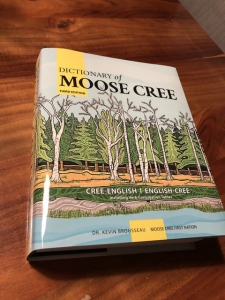
Third Edition
Published in 2019, this edition is among the most comprehensive dictionaries of the Cree language ever published. It is a bidirectional bilingual dictionary of 942 pages containing 24,150 Cree to English entries and 3,787 English to Cree entries. Entries in this dictionary include sense numbering, cross-references such as synonyms and variants, and etymologies for loanwords.
Some unique features of this dictionary include the design of the English to Cree entries. These have been designed to help inform readers as to the manner in which words are formed in Cree. This edition also contains a redesigned and fully revised set of conjugation tables for all four classes of Cree verbs. Another notable introduction to this edition are the beautiful black-and-white illustrations provided by Cree artist Tim Whiskeychan, fifty of which are included in this edition. The artwork on the cover is a piece by Cree artist Holly Pichette that is on display at Fanshawe College campus in London, Ontario. As works in progress dictionaries can rarely be described in superlatives, but the artwork, the hardcover with gilded titles and sewn bindings, and the sleek design of the entries undoubtedly makes this particular edition the most beautiful Cree dictionary published to date.
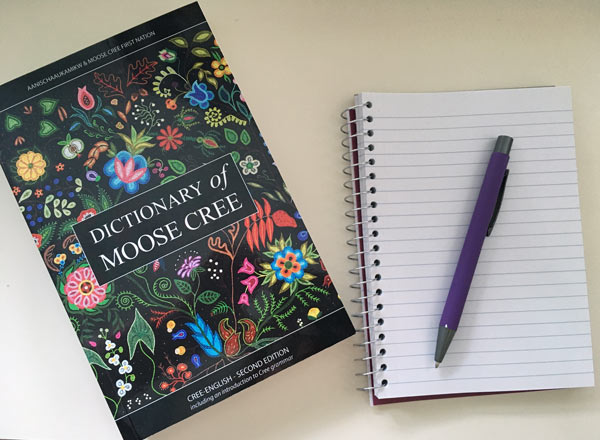
Second Edition
Also a beautiful edition, this one was covered in a work of art by renowned Michif artist Christi Belcourt. Published in 2015, a year after the publication of the first edition, this one is a unidirectional bilingual dictionary of 469 pages containing just over 9,300 Cree to English entries. This edition was published in collaboration with Aanischaaukamikw Cree Cultural Institute and was funded entirely by Moose Cree First Nation through the Amisk-oo-skow Agreement.
Entries in this edition include sense numbering, cross-references such as synonyms and variants, and etymologies for loanwords. Verb conjugation tables were introduced in this edition, which also included an introduction to Cree grammar.

First Edition
This first edition of the Dictionary of Moose Cree was published in 2014. It served as an initial attempt to garner local community support and arouse interest in revitalizing the Cree language locally.
This edition is a unidirectional bilingual dictionary of 249 pages containing just over 6,200 Cree to English entries. This edition was published in collaboration with Aanischaaukamikw Cree Cultural Institute and was funded entirely by Moose Cree First Nation through the Amisk-oo-skow Agreement.